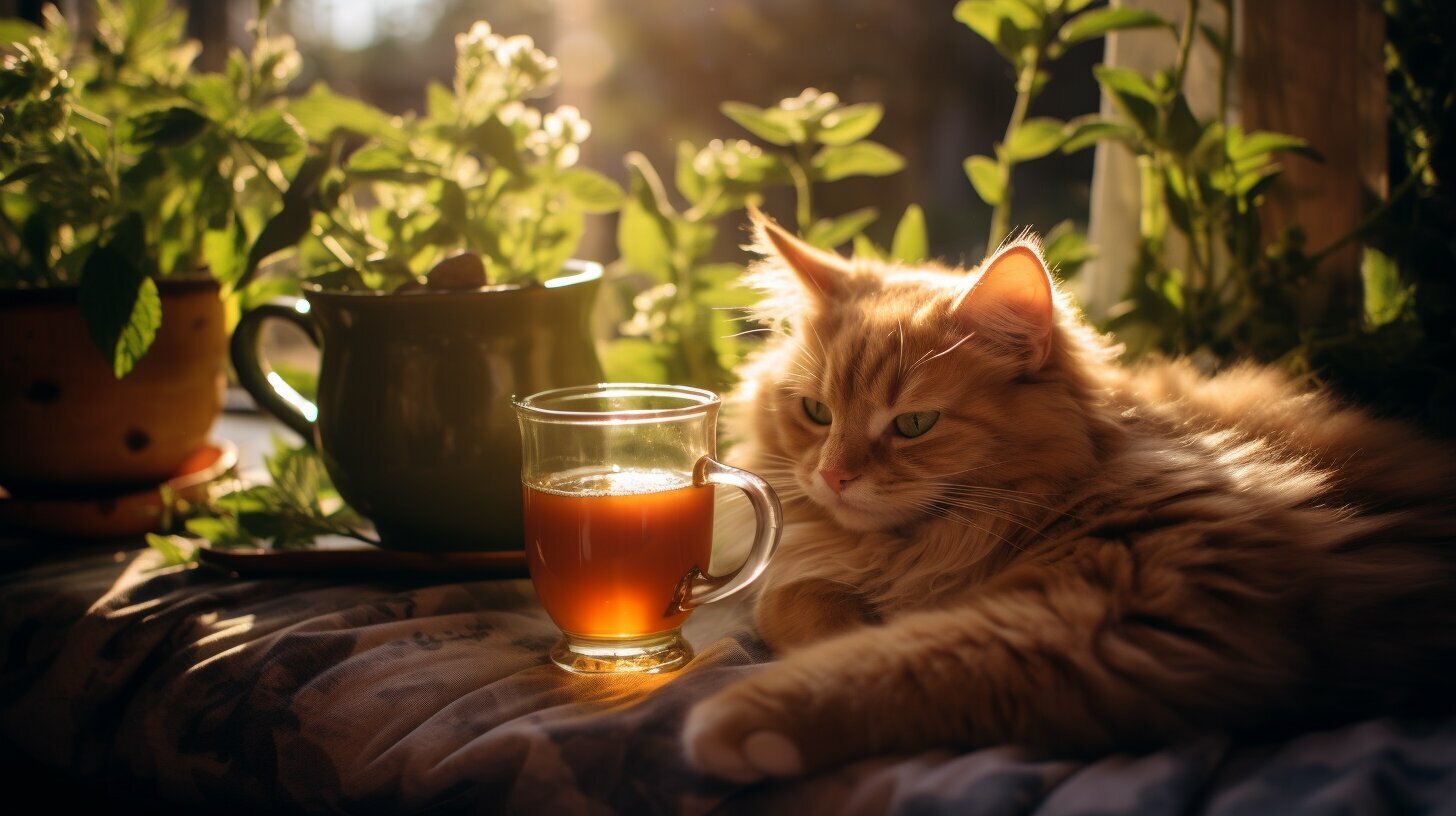Have you ever wondered how to make catnip tea? It’s surprisingly simple and easy to make. Not only does catnip tea offer a soothing and calming effect, but it also has various health benefits. In this article, I will guide you through the process of making catnip tea with a delightful recipe that you can try at home.
Key Takeaways:
- Catnip tea is easy to make and offers numerous health benefits.
- Follow this guide to learn how to make a delicious cup of catnip tea.
Understanding the Benefits of Catnip Tea
If you’re looking for a delicious and healthy herbal tea recipe, look no further than catnip tea. Not only does it offer a unique and aromatic flavor, but it also provides numerous benefits for the mind and body.
One of the most significant benefits of catnip tea is its ability to promote relaxation and reduce stress and anxiety. The natural compounds found in catnip can help soothe the nervous system and calm the mind, making it an excellent natural remedy for those struggling with stress or anxiety.
But that’s not all – catnip tea is also known to have sedative properties, making it a great option for those struggling with sleep issues. It’s also been suggested that catnip tea can help ease digestive discomfort and menstrual cramps, making it a great addition to your collection of herbal tea recipes.
Finally, catnip tea is also a great source of antioxidants, which can help protect the body against oxidative stress and reduce the risk of chronic diseases such as cancer and heart disease.
Overall, the benefits of catnip tea are numerous and diverse, making it an excellent choice for those looking for a healthy and delicious herbal tea option.
The Importance of Catnip Tea for Cats
As a cat owner, you might be wondering if catnip tea is safe and beneficial for your feline friend. The answer is yes! Catnip tea has several benefits for cats, including providing relaxation and mental stimulation.
Catnip, also known as Nepeta cataria, is a herb that belongs to the mint family. When cats smell or taste catnip, they can experience a range of reactions, including rolling, flipping, and rubbing their bodies against the herb. These reactions are caused by the chemical compound nepetalactone, which acts as a stimulant for cats.
While it’s safe for cats to consume catnip, you should still exercise caution when giving it to your pet. Too much catnip can result in overstimulation, leading to aggressive behavior or lack of coordination.
Catnip tea provides a milder and safer alternative to giving your cat dried catnip. The brewed tea can be added to your cat’s water or food, providing a subtle yet enjoyable flavor that can help them relax and reduce stress.
In addition, catnip tea can also be used to improve digestion and reduce inflammation in cats. It has mild sedative properties, making it a natural remedy for cats experiencing stomach issues or discomfort.
Overall, catnip tea is a safe and beneficial addition to your cat’s diet. It can provide relaxation, mental stimulation, and alleviate health issues. Just remember to give it to your cat in moderation and watch for any adverse reactions.
Gathering the Ingredients for Catnip Tea
Before we begin brewing our homemade catnip tea, let’s gather all the necessary ingredients. This catnip tea recipe is incredibly easy to make and requires minimal ingredients, making it a perfect addition to your collection of homemade herbal tea recipes.
| Ingredients | Quantity |
|---|---|
| Catnip leaves or teabags | 1-2 teaspoons or 1-2 bags per cup of water |
| Water | 1 cup per serving |
| Honey (optional) | To taste |
If you don’t have access to fresh catnip leaves, you can easily find catnip teabags at your local health food store or online. The quality of your catnip will directly impact the taste and effectiveness of your tea, so make sure to choose the highest quality catnip available.
Using filtered or spring water is also recommended, as it will improve the overall taste and quality of your catnip tea.
Feel free to add a dash of honey to your catnip tea for added sweetness, or leave it out entirely if you prefer a more herbal taste.
Step-by-Step Guide to Making Catnip Tea
Now that you’ve gathered all the necessary ingredients, it’s time to start brewing your very own cup of catnip tea. Follow my step-by-step guide to make catnip tea with ease:
- Boil 2 cups of water in a small saucepan.
- While the water is boiling, rinse 2 tablespoons of fresh catnip leaves under cold water. Remove any stems or seeds and dry the leaves using a paper towel or a clean cloth.
- Once the water has boiled, add the catnip leaves to the saucepan and turn off the heat.
- Cover the saucepan and let the mixture steep for 5-10 minutes. The longer you steep, the stronger the flavor.
- Strain the mixture into a teapot or a cup, using a fine mesh strainer or cheesecloth to remove any leftover leaves.
- Add honey or lemon to taste, if desired.
- Serve warm and enjoy your delicious and soothing cup of catnip tea.
You can experiment with different amounts of catnip leaves and steeping times to find the perfect balance of taste and aroma. Remember to let the tea cool down a bit before drinking.
Catnip tea can also be enjoyed cold. Simply follow the same steps and let the mixture cool down in the fridge before serving over ice.
Making catnip tea is easy and fun, and the end result is a delicious and healthy homemade herbal tea that you can enjoy anytime.
Discovering the Effects of Catnip Tea
As you sip your cup of catnip tea, you may notice various effects on your body and mind. Catnip tea is known for its calming properties, making it an excellent choice for those seeking relaxation after a long day. The soothing effects of catnip tea may help to promote sleep and alleviate stress and anxiety.
In addition to its calming properties, catnip tea is also believed to have other potential effects. Some people believe that it can help with digestive issues, including stomachaches and bloating. Others claim that catnip tea can be used to ease headaches or menstrual cramps.
While the effects of catnip tea may vary from person to person, there is no denying the pleasant and aromatic flavor it offers. Whether you are a fan of herbal teas or simply seeking a new and exciting beverage to enjoy, catnip tea is worth a try.
As with any herbal tea, it’s important to consult with a healthcare professional if you have any concerns or medical conditions that may interact with catnip. Otherwise, sit back, relax, and enjoy all the potential benefits of this delightful herbal tea.
Exploring Different Uses for Catnip Tea
While catnip tea is primarily known for its calming properties, it also has several other potential uses. Here are some of the ways you can incorporate catnip tea into your daily routine:
1. Digestive Aid
Drinking catnip tea may help soothe digestive issues such as indigestion, bloating, and nausea. The herb has antispasmodic properties that can relax the muscles in the digestive tract, reducing discomfort and improving bowel movements.
2. Headache Relief
Catnip tea may also help alleviate headaches, especially those caused by tension and stress. The tea’s calming effects can help reduce muscle tension and promote relaxation, easing the pain and discomfort associated with headaches.
3. Menstrual Cramp Relief
For those who suffer from menstrual cramps, catnip tea may provide some relief. The herb’s anti-inflammatory properties can help reduce inflammation in the uterus and relieve cramping. Additionally, catnip tea’s calming effects can help alleviate the stress and anxiety often associated with menstrual cramps.
4. Catnip Tea Bath
Aside from drinking catnip tea, you can also use it in a relaxing bath. Add a few cups of brewed catnip tea to your bathwater for a soothing and calming experience. Catnip tea has natural astringent properties that can help tighten and tone the skin while leaving it feeling soft and smooth.
With these various uses, catnip tea can be a versatile addition to your collection of herbal tea recipes. Try incorporating catnip tea into your daily routine and experience its potential benefits.
Tips and Variations for Catnip Tea
If you’re looking to customize the taste and aroma of your catnip tea, here are some helpful tips and variations:
| Tip/Variation | Description |
|---|---|
| Adding honey | The sweetness of honey can complement the earthy flavor of catnip tea. Try adding a teaspoon of honey to your cup before enjoying. |
| Using fresh catnip | While dried catnip works just fine, if you have access to fresh catnip, try using it to create a more potent and aromatic cup of tea. |
| Adding lemon | For a citrus twist, squeeze a lemon wedge into your cup of catnip tea. This not only adds flavor but can also enhance the calming effects of catnip. |
| Mixing with other herbs | Catnip tea can be blended with other herbs to create a unique flavor profile. Consider combining it with chamomile for added relaxation or peppermint for a refreshing twist. |
These tips and variations can help you experiment with different flavors and find the perfect cup of catnip tea that suits your taste preferences and needs. Enjoy the process of creating your own custom herbal tea recipe!
Catnip Tea for Anxiety – A Closer Look
Are you feeling anxious or stressed? Catnip tea may be the natural remedy you need. Studies have shown that catnip tea has relaxing properties, making it an excellent option for those looking for a natural way to manage anxiety.
The active compound in catnip tea, nepetalactone, stimulates the same receptors in the brain as valerian root, a popular natural remedy for anxiety and insomnia. This makes catnip tea a great alternative for those who do not want to take traditional medication.
Catnip tea has a calming effect on both the mind and body. It can help reduce racing thoughts and soothe tense muscles, providing a sense of tranquility and relaxation. Drinking a warm cup of catnip tea before bed can also promote better sleep, which is essential for managing stress and anxiety.
It’s important to note that while catnip tea is generally safe, it’s always a good idea to speak with your doctor before using it as a natural remedy for anxiety. Additionally, if you are pregnant or breastfeeding, it’s best to avoid catnip tea altogether.
Incorporating catnip tea into your daily routine can be an effective way to manage anxiety and promote a sense of calm and relaxation. Try adding it to your collection of natural remedies for stress and experience the soothing effects for yourself.
Safety Precautions and Considerations
While catnip tea is generally safe for consumption, it’s important to keep a few safety precautions and considerations in mind when making and drinking it.
First and foremost, make sure you are using high-quality catnip. It’s best to use organic catnip that is meant for consumption, rather than the dried leaves and stems meant for cat toys.
Additionally, pregnant women should avoid consuming catnip tea due to its potential effects on the uterus. Individuals with liver or kidney disease should also consult their healthcare provider before drinking catnip tea, as it can have mild diuretic effects.
Before trying catnip tea, test for any allergic reactions by consuming a small amount and waiting to see if any adverse effects occur. If you experience any discomfort or adverse reactions, stop consuming the tea immediately and consult a healthcare provider.
Lastly, keep in mind that catnip tea is not a substitute for professional medical treatment or advice. If you experience chronic stress, anxiety, or any other health concerns, speak to a healthcare professional.
Tips and Variations for Catnip Tea
If you’re looking to mix things up and experiment with your catnip tea recipe, here are a few tips and variations to try:
- Add a squeeze of fresh lemon or a drizzle of honey for a tangy or sweet taste.
- Try steeping your catnip with other herbs, such as chamomile or lavender, for a more complex flavor.
- Experiment with different ratios of catnip to water to find your perfect strength.
Get creative and enjoy the process of finding your perfect catnip tea recipe!
Embracing the Tranquility of Homemade Catnip Tea
There is something incredibly calming about making homemade herbal tea, especially catnip tea. The process of selecting the ingredients, boiling the water, and steeping the tea can be a meditative experience that promotes relaxation before you have even taken a sip.
One of the benefits of making catnip tea at home is the ability to customize the taste and aroma to your liking. You can experiment with different amounts of catnip, honey, or lemon to create a truly unique blend that suits your preferences.
Drinking catnip tea can provide numerous benefits, including improved digestion, relief from headaches, and easing menstrual cramps. Plus, the natural sedative properties of catnip tea can promote relaxation and calmness, making it an excellent addition to your evening routine before bed.
So, put on some soothing music, light a few candles, and embrace the tranquility that comes with making your own homemade catnip tea. You will be amazed at how this simple ritual can help promote a sense of calm and relaxation in your life.
Conclusion
In conclusion, making catnip tea is a simple and rewarding process that offers numerous benefits for the mind and body. By following the easy steps outlined in this article, you can create a soothing cup of catnip tea that brings tranquility into your life. Remember to gather all the necessary ingredients, follow the step-by-step guide, and customize the taste and aroma to suit your preferences. Whether you’re looking for a natural remedy for stress and anxiety or simply enjoy the taste and aroma of herbal tea, catnip tea is a versatile and enjoyable option. So, if you’re looking to try something new, why not embrace the peace and serenity of homemade catnip tea? Start incorporating catnip tea into your daily routine and experience a sense of calm and relaxation like never before. Trust me; it’s worth it! Thank you for reading this article on how to make catnip tea. I hope you found it informative and helpful. Don’t hesitate to try the catnip tea recipe for yourself and let me know how it turns out. Happy brewing!Can the Method of Making Loose Leaf Tea at Home be Applied to Making Catnip Tea as Well?
Making loose leaf tea at home is a delightful process that allows for customization and control over flavors. However, applying the same method for making catnip tea may not yield the desired results. Catnip tea requires specific considerations, such as using dried catnip leaves and steeping for a shorter duration. So, while you can make loose leaf tea at home with ease, making catnip tea requires some adjustments.
Can the Same Steps Be Applied to Making Bubble Tea at Home?
Making bubble tea at home is a delightfully simple process with endless customization options. The same steps used in tea shops can be easily applied to make bubble tea at home. From choosing your favorite tea base to adding delightful toppings like chewy tapioca pearls, creating your own bubble tea concoction is a fun and rewarding experience.
FAQ
How do I make catnip tea?
To make catnip tea, follow these simple steps: 1. Boil water. 2. Add dried catnip leaves to a teapot or infuser. 3. Pour the boiling water over the catnip leaves. 4. Let it steep for 5-10 minutes. 5. Strain the tea into a cup. 6. Enjoy!
What are the benefits of catnip tea?
Catnip tea has several benefits, including its calming properties, which can help alleviate stress and anxiety. It is also known to aid digestion and promote relaxation and sleep.
Can cats drink catnip tea?
Yes, cats can drink catnip tea. In fact, it can provide them with relaxation and mental stimulation. However, it’s important to consult with a veterinarian before giving catnip tea to your cat.
What ingredients do I need to make catnip tea?
To make catnip tea, you will need dried catnip leaves and boiling water. Optionally, you can add honey or lemon for added flavor.
Can catnip tea have any side effects?
While catnip tea is generally safe, some individuals may experience mild drowsiness or an upset stomach. It’s always best to start with a small amount to see how your body reacts.
Can I use catnip tea for anxiety?
Catnip tea has been used as a natural remedy for anxiety and stress. It may help promote relaxation and a sense of calm. However, it’s important to consult with a healthcare professional if you are seeking treatment for anxiety.
Are there different variations of catnip tea?
Yes, you can customize the taste and aroma of catnip tea by adding other herbs or spices. Some popular variations include adding chamomile, lavender, or mint leaves.
How often should I drink catnip tea?
The frequency of drinking catnip tea is a personal choice. It’s recommended to start with a cup or two per day and observe how your body responds. Adjust the intake based on your preferences and any potential effects.
Can I give catnip tea to children?
It’s best to consult with a pediatrician before giving catnip tea to children. While it is generally safe for adults, children may have different reactions or sensitivities.
Can I use fresh catnip leaves instead of dried leaves?
Yes, you can use fresh catnip leaves to make catnip tea. Simply substitute the dried leaves with an equal amount of fresh leaves.
Where can I buy catnip leaves for making tea?
You can purchase catnip leaves from health food stores, herbal apothecaries, or online retailers specializing in herbs and herbal teas.



